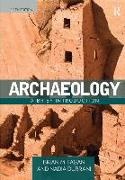Read more
List of contents
Chapter 1Fossils, Cities, and Civilizations: The Birth of a ScienceChapter 2Introducing Archaeology and PrehistoryChapter 3Culture and ContextChapter 4Explaining the PastChapter 5Space and TimeChapter 6They Sought It Here, They Sought It There: The Process of Research and Finding Archaeological SitesChapter 7ExcavationChapter 8Archaeological Classification and Ancient TechnologiesChapter 9The Present and the PastChapter 10Ancient Climate and EnvironmentChapter 11Come Tell Me How You LivedChapter 12Settlement and LandscapeChapter 13The Archaeology of PeopleChapter 14Managing the PastChapter 15So You Want to Become an Archaeologist?
About the author
Brian Fagan is one of the world’s leading archaeological writers and an internationally recognized authority on world prehistory. He is Emeritus Professor of Anthropology at the University of California, Santa Barbara. His other textbooks include A Brief History of Archaeology; Ancient Civilizations (with Chris Scarre); Ancient Lives: An Introduction to Archaeology and Prehistory; In the Beginning; People of the Earth (both with Nadia Durrani); and World Prehistory: A Brief Introduction. He is also the author of numerous general books on archaeology.
Nadia Durrani is a Cambridge University-trained archaeologist and writer, with a PhD from University College, London, in Arabian archaeology. She is former editor of Britain’s best-selling archaeology magazine, Current World Archaeology. and has authored and edited many hundreds of articles on archaeology from every corner of the globe, contributed to dozens of books, and written two: The Tihamah Coastal Plain of South-West Arabia; and In Search of the Zeppelin War: the archaeology of the First Blitz (with Neil Faulkner).
Summary
Archaeology is a jargon-free and accessible introduction to the field which details how archaeologists study the human past in all its fascinating diversity. Now in its twelfth edition, this classic textbook has been updated to reflect the latest research and new findings in the field. Reflecting the global scope of the discipline, the book has a truly international coverage of important discoveries and sites from many corners of the globe. Individual chapters examine archaeology and its history, considering the role of the archaeologist and how they discover, investigate and classify sites and artifacts.
This journey through archaeology also includes a discussion of important individuals and groups, and some of the ways in which archaeologists attempt to explain major social and cultural changes in the remote past. Archaeology ends with an outline of the complex world of cultural resource management and gives invaluable advice on how to become an archaeologist. Richly illustrated throughout, this popular and engaging textbook on archaeological methods has introduced generations of students to the captivating world of archaeology.

